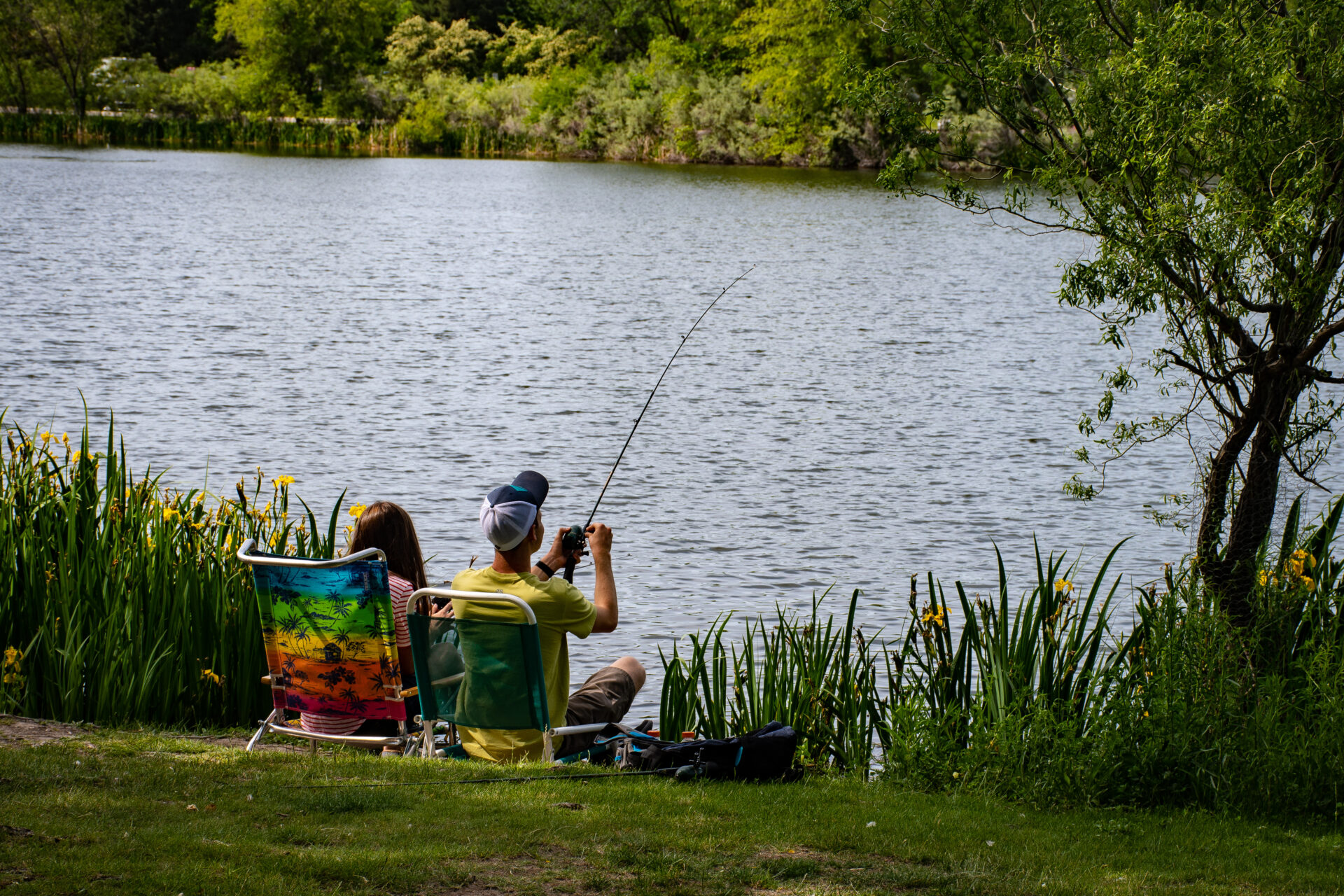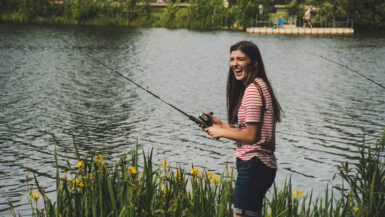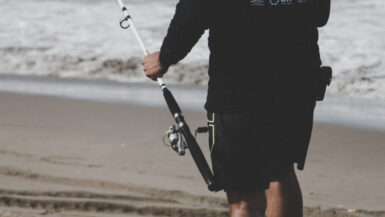Fishing for crappie in deep water can be a great way to add some excitement and challenge to your fishing experience. Crappie can be found in rivers, lakes, and other bodies of water, and they are especially prevalent in deeper waters. Whether you’re an experienced angler or a beginner trying to learn the basics, knowing how to fish for crappie in deep water can make all the difference in your success. In this article, we’ll cover the basics of Crappie fishing in deep water: from the types of lures to use, to the best times to fish, to the technique and rigging that will result in the greatest catches.
Gather Your Supplies
It is important to have the right gear before heading out to catch crappie in deep water. A good rod and reel are essential and should be matched to the size and type of fish you are targeting. Anglers should also be sure to bring a tackle box with the right lures, hooks and swivels. You may also want to add weights, a stringer, and a net to your tackle box. It is also wise to bring along polarized sunglasses to help spot fish, a hat for sun protection, and waders if you plan on wading in deep water.
Find the Right Fishing Spot
Once you’ve gathered the necessary supplies, you’ll need to find a suitable spot to fish for crappie in deep water. Start by looking for deep-water spots on your lake, river, or pond. Search for areas where the bottom drops off quickly, and look for large branches and logs that may be providing cover for the fish. If you don’t have luck finding deep water near the shore, consider a boat or kayak to get further out.
Choose the Right Bait
Bait selection is an important part of deep-water crappie fishing. You’ll need to choose the right type of bait that will entice the fish to strike. Live bait such as minnows and crickets are great, or you can use artificial lures like spinners, jigs, and crankbaits. Experiment with different lures to see which works best, and remember to cast in different spots to increase your chances of catching fish.
Be Patient and Enjoy the Journey
Deep-water crappie fishing can be rewarding, but it is important to be patient and enjoy the process. Take your time and enjoy the scenery, and be sure to have a plan before you cast your line. With a bit of preparation, careful attention to detail, and a little luck, you can be sure to have a successful outing catching crappie in deep water.
Identify a Deep Water Location
Choosing the right location to fish for crappie in deep water is essential for success. The best crappie fishing spots are typically located in deep water that’s at least 10-15 feet deep. Look for areas near underwater structures such as logs, rocks, weeds, or bridge pilings. These underwater structures provide habitat for small baitfish and crawfish, which in turn attract hungry crappie.
Bait to Use When Fishing for Crappie in Deep Water
When fishing for crappie in deep water, live bait is usually the best option. Live minnows and jigs are two of the most popular baits for catching crappie in deeper waters. Live minnows are great for attracting crappie and typically work best when dropped directly above the structure. Jigs are great for targeting crappie that are suspended in the water column and can be used to probe different depths.
Best Technique for Fishing in Deep Water
The best technique for fishing for crappie in deep water is to use a slow and steady retrieve. Crappie are often found at the same depth throughout the day, so it’s important to move slowly and cover a lot of water. Use your rod tip to work the bait and make sure to vary your trolling speed and jigging motions. It can also be helpful to use a trolling motor to maintain a steady speed. By covering more water and experimenting with different techniques, you will increase your chances of success.
Choose the Right Rig Setup
Fishing for crappie in deep water requires the right rigging setup to make sure you can effectively target and hook the fish. Depending on the type of water you are fishing, the depth, and your desired technique, different rigs may be better for different conditions. Generally, a standard two-hook rig is suitable for most fishing situations, but you may need to adjust the rig setup depending on the conditions.
Choose the Right Hooks
Hooks play an important role in fishing for crappie in deep water. When targeting crappie in deeper water, it is important to choose a hook that is strong enough to withstand the pressure of the deeper depths and the powerful crappie. Generally, small treble hooks are best for fishing deeper water as they can better handle the strong crappie and the depths.
Consider Using Drop-Shot Rigging
Another effective rigging setup for fishing for crappie in deeper water is the drop-shot rig. This rig is popular with many anglers because it can be adjusted to target different depths. To make a drop-shot rig, you will need a hook, a weight, and a leader. The weight can be adjusted according to the desired depth, and the leader should be long enough to ensure the hook is at the bottom of the water column. With the drop-shot rig, you can effectively target different depths and give the crappie more of an opportunity to bite.
Utilize a Slip-Float Rigging
Slip-float rigging can be an effective technique for targeting crappie in deeper water. This rigging setup uses a longer leader and a weight to keep the bait at the desired depth. The weight can be adjusted to help you target deeper waters and the length of the leader can be adjusted to give the fish more time to bite. To make a slip-float rig, you will need a hook, a slip-float, a weight, and a leader. By adjusting the length of the leader and the weight, you can fine-tune the rig to the desired depth.
Think About Live Bait Options
Live bait can be a great option when fishing for crappie in deeper water. Live bait can be used in addition to, or instead of, lures or artificial bait. Live bait rigs can be adjusted accordingly to target the desired depths. For example, you can attach a jig head to a live bait and adjust the weight to target different depths. Live bait can also be attached directly to a hook for a more natural presentation.
By understanding the different rigging requirements and options for fishing for crappie in deep water, you can make sure that you are properly equipped and prepared for the conditions. With the right rigging setup and the right live bait, you can increase your chances of catching crappie in deep water.
Match Your Lure
Fishing for crappie in deep water provides anglers with a thrilling experience and access to a wide variety of fish. Whether you’re fishing for a few hours in a well-stocked pond or spending a day out on the open water, crappie can provide you with plenty of fun and excitement. If you’re looking to catch some of these delicious fish, you’ll need to know the basics of deepwater fishing.
Preparation Is Key
To fish for crappie in deep water, you’ll want to be sure to have the proper supplies. This starts with the right rod and reel. Crappie are usually caught with light tackle, so you’ll want to use a spinning reel with a light test line. You’ll also want to be sure to have a variety of baits, lures, and hooks.
In addition to your fishing supplies, you’ll also want to bring along a topographic map of the area you’ll be fishing. This will help you identify areas with deeper water and potential hot spots. You’ll also want to bring along plenty of food, water, and sunscreen – as temperatures can rise quickly in deep water areas.
Choose the Right Lure
When it comes to deep-water crappie fishing, the type of lure you choose can have a huge impact on the success of your outing. It’s important to choose a lure that matches the depth of the water and the type of fish you’re targeting. For example, if you’re fishing for crappie in 10 to15 feet of water, you’ll want to use a jig that dives down to that depth. If you’re fishing in deeper water, you’ll want to use a lure that can dive even deeper.
Attracting Crappie
It’s important to keep in mind that crappie are attracted to structure, so look out for rocks, stumps, and other submerged objects. Crappie also tend to congregate in schools and move around in schools, so you’ll want to locate a school and set up your lures to attract them. You can also use a variety of techniques to entice crappie, such as jigging, trolling, and bottom bouncing.
Know When to Bite
Crappie are a nocturnal species, and tend to be most active at night or during periods of low light. To maximize your chances of catching crappie in deep water, it’s best to plan your outing around these times. Additionally, crappie tend to move around in cycles, so if you’ve had success in one area, give it some time and try fishing there again at a later date.
By following these tips, anglers can have a successful and enjoyable crappie fishing trip in deep water. With the right preparation, knowledge, and supplies, you can be hauling in the big one in no time.
Experiment With Different Depths
If you’re looking to catch crappie in deep water, it is important to understand the concept of depth and experiment with different depths to see which works best. Using a depth finder is a great way to learn more about the water’s depths and where you should target your fishing efforts.
Target the Right Depth Range
Depth is a significant factor when trying to locate crappie in deep water. Though they may move up to shallower waters in search of food, they usually prefer depths up to 20 to 25 feet. Move around and experiment with deeper or shallower depths until you find where the crappie are.
Locate Structure in Deep Water
Structure such as drop offs, ledges, humps and sunken points are great places to search for crappie in deep water. This type of structure creates the perfect niche for crappie to ambush bait fish that come in search of food. Using a depth finder to locate these areas can be of great help.
Look for Schools of Crappie Feeding
Naturally, you should always look for schools of crappie feeding. If you spot a school, mark the area and slowly drift back to the spot. Then drop down your line, using a Minnow or a Jig head with a soft plastic tail. This will attract the crappie in the area and help you to catch more.
Use the Right Lure or Bait
Using the right lure or bait is a crucial element when fishing for crappie in deep water. As mentioned, jig heads or soft plastic tails are great to use. You can also try using a variety of live bait such as worms and crickets. Additionally, using a small crankbait, spinnerbait or even a jigging spoon is a great way to attract crappie. Experiment with different lures and baits to find out what works best.
Use the Right Gear and Techniques
It is important to use the right gear and fishing techniques to successfully catch crappie in deep water. Lightweight fishing rods and reels are ideal when fishing in deep water as they allow you to feel the bite more easily. Additionally, slow trolling is a good technique to use when fishing for crappie in deep water. This is because trolling allows you to move around and cover more ground in search of crappie.
By understanding the concept of depth, targeting the right depth range, locating structure in deep water, looking for schools of crappie feeding, using the right lure or bait, and using the right gear and techniques, you will have a much better chance of landing some crappie in deep water. So if you’re looking to take a break from shallow water fishing and try something different, give deep water fishing a shot!
Navigate the Structure
Deep water crappie fishing will require different tackle than fishing in shallow water. Lures used should be of the right size and weight as crappie in deep water will be typically smaller than those in shallow water. A small jig head, with a minnow or jigging spoon attached, is usually the most effective method. Sinkers are also essential to cast the lure and bait to the desired depth.
Find Deep Water Holes
Crappie will generally stay in deep water holes near the shoreline. To locate these, look for signs such as rocks, vegetation, drop-offs, and logs. Fish finders can be used to identify deeper areas. Be sure to also keep an eye out for other fish species, as crappie typically stay in the company of other species.
Cast to the Structure
Once the deep water structure has been located, it is time to cast. Start by casting the lure to the center of the water hole and slowly reel it back. Try using different depths until the crappie start biting. It is also important to cast to the edges of the deep water hole. If a strike occurs, be sure to move slowly and steadily in order to not spook the fish.
Move with the Wind
Wind can affect the movement of deep water crappie. If the wind is blowing in one direction, it may be necessary to constantly move the boat, in order to stay directly in the wind’s path. This will help to keep the lure in the water, and prevent the fish from being spooked.
Adjust Bait or Lure for Maximum Effect
Adjusting the type of bait or lure used can help to increase chances of a catch. Experimenting with different colors and sizes is important and can help to determine which type of bait the crappie prefer. Adding a small spinner to the lure can also help to draw more attention.
Fishing Crappie in Deeper Water
Fishing for crappie in deeper water can be a great way to catch more fish. When fishing deep water, it is important to use a light-weight line, select the right type of bait, and fish in areas with natural structure. To find success, anglers should use a jigging technique with a twitching action to attract the fish. In addition, using a slip bobber can help you keep your bait in the strike zone for longer periods of time. With patience and persistence, your hard work can be rewarded with a good catch. Whether you are a beginner or experienced angler, fishing for crappie in deep water is an enjoyable and rewarding experience.





Leave a reply